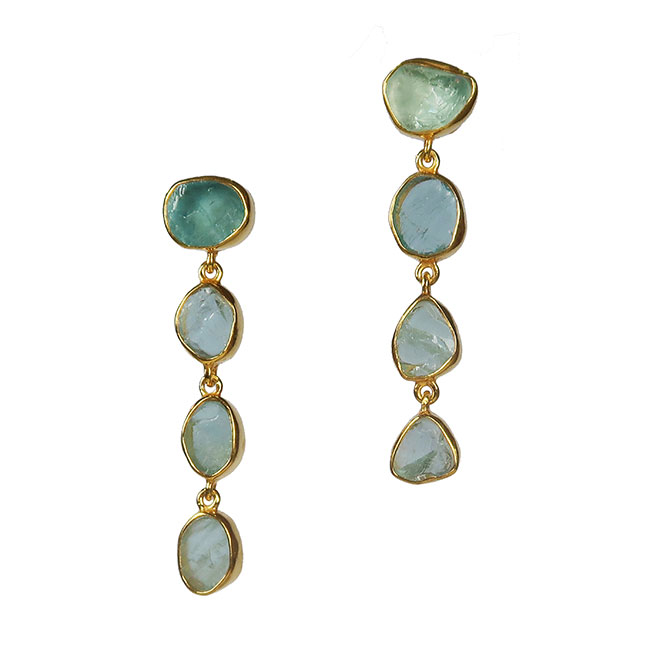The healing properties of gemstones and their history, their use in healing rituals and as protective talismans is a long and varied one. Whatever your beliefs about the properties of gemstones and their uses today it’s fascinating to delve into their healing past. Almost every significant human culture across every continent has used semi-precious stones as a source of healing and well-being from the Aborigines of Australia to the Ancient Greeks and everyone in-between. Here at Sushilla we believe that understanding the background of our stones is key to appreciating their true beauty and with that in mind we have delved into the history of healing gemstones and created a healing glossary of those stones we use today.
We know that cultures used gemstones or crystals in different ways and for their different attributes. The Romans were fond of crystal amulets to promote health, healing and personal advancement. The Egyptians placed such significance on the power of gemstones that their dead were laid in tombs with a quartz stone on their head to allow them safe passage to the afterlife and in Hindu culture the specific healing properties of gemstones are reference in the Vedas, an ancient and sacred text. The Greeks who give us the word crystal from their ‘krustullos’, translating as ice or ice of the gods, rubbed crushed hematite over warrior’s bodies before battle to afford protection and even invincibility.
So what does gemstone healing look like today? Crystal therapists place relevant gem stones around the body at Chakra or acupuncture points or may include crystals as part of a complementary therapy like massage. It may be that significant gemstone is held, slept with under a pillow or worn to promote a healing effect. Some gemstones are said to more effective when bathed in moonlight or sunlight for a specified period of time or when heated, this is sometimes known as ‘charging’.
Proponents of gemstone healing suggest that specific crystals create different levels of vibration or energy that have a desired or directed effect on the body of the wearer and while this theory is open to argument it is certainly the case that wearing a specific piece with a clear intention is a strong psychological tool. It is also a way to connect not only with our ancient past but with the ancient earth with these wonderful semi-precious stones being formed over thousands if not millions of years within the heart of our planet.
We choose stones for their, beauty and their meaning so explore a glossary of the Sushilla stones and their proposed healing properties below.
Amethyst
Amethyst is connected with calming and balancing mental energies and is connected in Hindu culture with balancing the Brow or Third Eye Chakra, allowing us to be more creative and happy in our inner world. Sometimes referred to as the all healing stone Amethyst is said to be helpful in treating a number of conditions, in particular those related to inflammation including arthritis. Amethyst also has a long history of improving sobriety be that in relation to drugs or alcohol.
Apatite
Blue Apatite is known for assisting in achieving personal goals, improving motivation and is also said to be helpful for public speaking, it’s therefore a great stone for a business person or entrepreneur. Physically Apatite is linked to the promotion of healthy bones and with aiding weight loss. As a Chakra stone Apatite reduces blockages and allows all Chakras to function together more harmoniously.
Aquamarine
Aquamarine is a stone of communication, associated with the Throat Chakra it is said to improve the ability to present yourself honestly and speak in public. Emotionally it is linked with overcoming past traumas and positive forward momentum. It’s physical healing properties are respiratory based and it is alleged to improve conditions such as Asthma.
Black Spinel
Black Spinel, despite it’s dark colour is a stone associated with positivity. It is linked to overcoming negative thoughts and feelings and is said to have a detoxifying effect on the body. This means it has been used to treat digestion and reproductive issues.
Blue Topaz
The Blue Topaz is sometimes called the writers stone due to its proposed ability to positively influence written and spoken communication skills. It is linked to the Third Eye Chakra and mental clarity. The Romans associated Topaz with healing chest ailments and it has been linked with protection against heart conditions.
Chalcedony
Chalcedony is a stone of calm and reflection and is associated with positive and thoughtful communication. It has been linked to treatment of mental ailments such as depression and Alzheimer’s and is connected with the Throat Chakra improving communication problems for people who speak for a living such as actors and lawyers.
Chrysoprase
The background of Chrysoprase is an interesting one, it was historically linked with invisibility and it was believed that a piece placed in the mouth of a condemned prisoner may spare him execution. Now Chrysoprase is linked with emotional healing and with recovery after heart ache. Its physical applications have been linked to diseases of the skin and liver and with fertility problems.

Citrine
Citrine is a stone associated with wealth and positivity, it is linked to the Navel and Solar Plexus Chakras and this is said to increase the ability to make positive decisions and improve focus. It has been connected with an improvement in physical ailments related to lack of energy such as Chronic Fatigue Syndrome.
Drusy
The attractive sparkle of Drusy is matched by its reputed power to balance mood and reduce stress and depression in some people. It is also linked to physical balance and the improvement of conditions linked to poor circulation.
Flourite
Learning is a key quality associated with the Flourite stone which is said to improve concentration, clarity and block out distractions. This ability to bring about mental clarity is also said to make it useful in decision making. It’s crystal healing properties include treatment of cholesterol, insomnia and protection against colds and flu.
Iolite
Iolite has an illustrious past being used by the Vikings as an early navigation tool. Iolite is said to promote a strong and healthy constitution, aid in resolving disharmony and problems and protect against headaches and insomnia.
Labradorite
The Inuit people respect Labradorite as a piece of the Northern Lights fallen to earth and it is connected with the mystic and the magical. It is indeed linked to an increase in psychic and healing abilities and is said to make hands more sensitive and effective in professions such as physiotherapy. Labradorite stimulates the Throat Chakra and improves communication, it is also linked to the healing of respiratory disorders.
Moonstone
Moonstone is a stone connected deeply with love and is said to open up the hearts ability to find and receive love. It has been used as a gift or talisman for lovers or couples in Indian, Roman and other cultures for millennia. Moonstone is linked to healing of fertility and reproductive issues and is also connected with soothing sleep problems especially in children.
Morganite
Sweet pink Morganite is, like its colour, linked to the heart. It is associated with both the physical protection of the heart along with emotional healing and the balancing of feelings. Morganite is tied to the Heart Chakra and is thought to bring calm to relationships.
Prehnite
Prehnite is said to bring protection to the wearer and bring relief from worry. It is also linked to improve meditation ability and an increase in psychic energy. Linking the Solar Plexus and Heart Chakras Prehnite is said to combine the heart and the will to enable achievement of goals.
Quartz
Quartz is regarded as a very diverse and important healing stone. It is often used in conjunction with other gemstones as it is said to have an amplifying effect. Emotionally Quartz is a cleansing stone said to increase positivity and increase connection to the spiritual realm. Quartz can also help harmonise all Chakra energies creating overall positivity, it used to treat headaches, exhaustion and improve the metabolism.
Rhodochrosite
Rhodochrosite like many pink stones is associated with the heart but is said in a particular said to encourage a positive and selfless feeling of love for those around us along with self-love and acceptance. It is associated with treatment of heart and circulatory conditions.
Ruby
Ruby is a precious gem stone, historically associated with royalty. It is linked with the emotional properties of courage, love and self-belief. Physically it is associated with reducing menstruation pain and improving conditions of circulation. Ruby is associated with the Base Chakra and the stimulating of life force or ‘Chi’.
Ruby Zoisite
Ruby Zoisite combines the qualities of its component gem stones balancing the fire of Ruby with the earth of Zoisite. It is therefore linked with helping with mood balance and psychological conditions. Ruby Zoisite has a reputation as a fertility enhancer.
Sapphire
The Sapphire is considered a highly spiritual stone in Jewish, Buddhist and Hindu lore. It is meant to support spiritual commitment and awareness as well as calm the mind. It is also a symbol of devotion, hence its popularity in engagement rings. Sapphire is linked to improving conditions of the eyes and ears as well as promoting restful sleep, it is said to promote self-understanding.
Tanzanite
Tanzanite is a stone that connects three key Chakras, the Throat, Third Eye and Crown, this leads to its ability to unite mind, intuition and our ability for clear communication. It is linked to speaking our true feelings and relief from worry. Physically Tanzanite is said to strengthen to immune system and treat nervous disorders.
Each semi-precious or precious gemstone has a cultural and social history linked to a wealth of meanings and reputed effects. Understanding a little more about these jewels means understanding a little more about ourselves and human history. So choose your next semi-precious piece with care, love and a deeper understanding of its significance.
Remember that whilst it’s fun to delve deeper into the world of semi-precious stones and understand the hidden meaning behind their beautiful facades, none of the above should be taken as medical advice.
Further information about this interesting subject can be found here.












